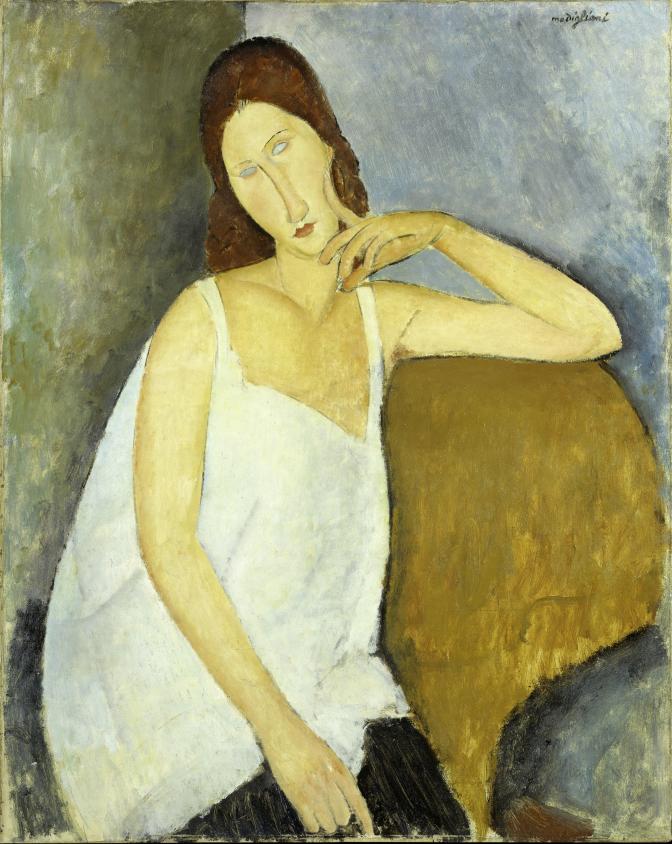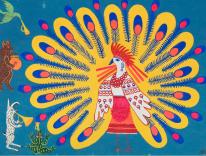It was an afternoon in May, 1933, and Henri Matisse, then sixty-two, had just returned to the Barnes Foundation in suburban Philadelphia. He was there to supervise the installation of his recently completed, monumental mural The Dance beneath the three soaring arches of the main room’s south wall. With its eight plump female silhouettes leaping, tumbling, and reeling against a barred background of black, blue, and pink, the work is mesmerizing: visit it today, and you’ll wonder at how Matisse’s riotous celebration of motion, pleasure, and connection makes a room full of masterpieces by the likes of Cézanne, Renoir, and Picasso seem somehow staid. Matisse had spent more than two years perfecting The Dance, working feverishly in a rented garage in Nice, sketching across huge canvases with charcoal attached to a long stick. Naturally, he was excited to show off the results.
So excited, in fact, that he gave himself a slight heart attack. In a wry letter to Matisse’s son Pierre, Albert Barnes recounted how, despite the presence of an expert gallerist, Matisse had “insisted” on climbing the scaffolding and mounting the first of the panels himself, working for hours with a hammer and nails before Barnes finally “gave him some whiskey and made him rest.” Barnes also sent for a heart specialist, who sternly cautioned Matisse against further exertion. “When a man reaches your father’s age,” Barnes explained to Pierre, “it is necessary for him to readjust his life to the changed conditions which advancing years bring on…. With proper care your father may still have many years of good life in front of him.”
Fortunately—as the Philadelphia Museum of Art’s phenomenal show Matisse in the 1930s confirms—Matisse didn’t listen. The Dance had helped him overcome a paralyzing creative crisis (“In front of the canvas, I have no ideas whatsoever,” Matisse had written in 1929) and he now felt more energized than ever. More than two decades of extraordinary work followed. Ceasing to worry about his reputation and in possession of a newfound confidence, Matisse’s subjects became simpler, his sparer lines more evocative, his compositions freer and more expansive.
That’s not to discount Matisse’s earlier modernist works, made in Paris during the 1900s and 1910s, including masterpieces like The Joy of Life (1905–6) and The Red Studio (1911). But by the late 1910s, those ideas had run their course. From Paris, Matisse relocated to Nice, where he began a sensuous series of seaside interiors and “odalisques,” a traditional (and highly Orientalist) genre of French painting. In these works, semi-nude female models laze amidst sumptuous furniture and fabrics “in the manner of harem concubines.” Arabesque (1924), Odalisque in Grey Pantaloons (1926–7), and Odalisque with Red Box (1927) dazzle viewers with a hypnotic array of patterns and objects, but the women, faces and bodies submerged in a sea of color, seem mere afterthoughts. Besides the problematic sexual and colonial politics, Mattise’s odalisques struck me as repetitive, more likely to bore than scandalize. Though Matisse always defended them, his 1927 Woman with a Veil hints at a different story: here Matisse’s jaded, fully clothed subject, holding her chin in hand with her eyes screened by a black veil, leans forward and stares penetratingly, as if offering a quiet rebuke.
Thankfully, Matisse didn’t stay stuck. The same processes he developed while working on The Dance (charcoal tracing, movable cartoons, a reduced palette) were put to powerful new use in works like Large Reclining Nude (1935), in which his desexualized model (and future caretaker) Lydia Delectorskaya appears as a spiraling geometrical abstraction, the wild curves of her limbs spiking like asymptotes against the lined Cartesian grid of her bed. Abstraction is present too in the minimalist black-and-white drawings Matisse began producing for illustrated books, including French symbolist poet Stéphane Mallarmé’s Afternoon of a Faun (1933) and James Joyce’s Ulysses (1934). The few details Matisse provides—a nymph reclining beside a row of trees, an oared ship gliding down the face of a wave—feel provisional and evocative, as if Matisse, instead of competing with the text for readers’ attention, is content to suggest a partial sketch for our own imaginations to complete.
A similar spirit of collaboration animates Matisse’s costumes and set designs for Rouge et Noir (1939), an avant-garde ballet choreographed by Léonide Massine. Set to music by the Russian composer Dmitri Shostakovich and conceived as a “vast mural in motion,” in which masses of spinning dancers alternatingly gather and scatter from opposite ends of the stage, the ballet incorporates the farandole, a Provençal folk dance that Matisse had studied as he was preparing sketches of The Dance. The installation, which recreates the arched backdrop of the set and features Matisse’s paper models of red-and-gold bodysuits mounted alongside a video of a performance, is the highlight of the show. It reveals a Matisse who conceives of art no longer as rivalry (his feuds with Picasso were legendary) but as collaboration, both with other artists and with earlier versions of himself. The show’s final gallery, filled with botanical still lifes and quickly drawn portraits that Matisse made in the 1940s while recuperating from a cancer operation, drives home this last point: revisiting and reworking former motifs with a less guarded, sloppier style becomes a way forward.
In his insightful review of Matisse in the 1930s, Washington Post critic Sebastian Smee observes the absence of politics in Matisse’s work in this period. It’s especially glaring because Matisse’s daughter Marguerite, who collaborated with the French partisans, was arrested and tortured by the Gestapo. In one sense, that’s true: instead of confronting Nazism and fascism head-on, Matisse plunged himself into form, color, myth, and art for art’s sake—and often for the sake of the rich, like Albert Barnes and Nelson A. Rockefeller, for whom Matisse made The Song (1938), a floor-to-ceiling mantelpiece that drew on earlier portraits like The Three Sisters (1917). It’s tempting, then, to dismiss Matisse as an aesthete. But is attentiveness to the beauty of the body and the spark of imagination it inspires—in short, the cultivation of humanism—really apolitical? If anything, Matisse’s work during the 1930s, with its exaltation of contact and motion and its frank admission of aging and vulnerability, does contain the seeds of a quiet revolution.
Had he lived past thirty-five, Italian painter Amedeo Modigliani might have arrived at abstraction, too. His distinctive modernist portraits, with their elongated features and mysterious blue-eyed gazes, are often paired with Matisse’s throughout the permanent galleries at the Barnes, highlighting their similar subject matter and overlapping time in Paris. If during those years (the early 1900s and 1910s) Matisse appeared as the consummate insider, his unimpeachable status as an artistic “influencer” bolstered by his methodical work habits and buttoned-up bourgeois appearance, Modigliani, a Jew from Livorno, was chronically on the outs, his career hampered by his propensity for drinking and affairs.
There’s a lot more to Modigliani than that, though, a point gracefully made by the Barnes’s new show. Modigliani Up Close features around fifty objects—portraits, nudes, and sculptures—grouped across five thematic galleries. Modigliani’s comparatively small output is partly a result of the short time he was active (he arrived in Paris in 1906 and died of tuberculous meningitis in 1920 in Nice). He only had one solo show in his lifetime, in 1917, and only gained recognition as one of the greatest artists of the twentieth century after his death. Modigliani’s works are now among the world’s most valuable; in 2015, a Chinese billionaire paid $170.4 million for Reclining Nude (1917), the second highest price ever recorded for a single painting.
A novelty of the Barnes show is the way it incorporates “scientific” or material analysis, which expands the study of art beyond biography and visual interpretation to include details about paintings and sculptures as physical and commercial objects. Mounted beside Modigliani’s canvases and sculptures are x-ray images accompanied by granular information about thread counts, paint pigments, and rasp marks. Visitors can use their smartphones to zoom in and learn more, though I confess I didn’t see too many doing so. Occasionally, it’s interesting. Drill marks confirm that in the early 1910s Modigliani likely robbed construction sites to obtain stones for making sculptures; wax residue hints that he probably mounted lighted candles on top of them in his studio, using them as makeshift lamps for his nocturnal painting sessions. For the most part, though, such information is too specialized and tends to get in the way of the works themselves.
If Matisse’s odalisques were evidence of artistic impasse, for Modigliani, nudes (he made about thirty of them in 1917) constituted a real breakthrough. From a technical standpoint, there’s much to admire: by layering bright, warm pinks atop a gray-blue base, Modigliani makes his subjects appear to glow against their darkened interior surroundings. He lavishes great care and attention on facial features and hairstyles, the precise brushwork mimicking a gentle caress. Still, there’s a kind of surface sterility inherent in such explicit, hypersexualized poses. (Modigliani was censured by Parisian critics for his inclusion of pubic hair.) It’s as if by showing too much, Modigliani reveals nothing. We get a lot of flesh, but not much else.
That all changed, though, after Modigliani also moved to Nice. He’d fallen in love with the young painter Jeanne Hébuterne, with whom he had a daughter in 1918. The Barnes show conveys this abrupt shift with a progression of increasingly clothed portraits—no longer of hired models, but of ordinary people Modigliani encountered in the south of France. The cast of characters ranges from fidgety peasant boys in shorts to circumspect middle-aged women and haughty industrialists. It’s at this point that Modigliani’s paintings—which combine the facial elongation of traditional African masks, the grave postures typical of Renaissance portraiture, and the experimental color schemes of French modernism—really start to gel.

Portraits of Jeanne pregnant with the couple’s second child are particularly poignant, and among the best in the show. In one, Modigliani depicts her seated placidly on her bed, her hands resting on her swollen belly in the fifteenth-century manner of Piero della Francesca’s Madonna del Parto; in another, Jeanne appears in a loose white shift, balancing her arm on a side table as her long fingers rest delicately across her cheek. It’s as if Jeanne has taught Modigliani to shift his gaze away from the dead end of sexual voyeurism and toward an appreciation of the subtle grace inherent in minute gestures.
Taken together, Matisse in the 1930s and Modigliani Up Close are important shows, arriving five years after the beginning of #MeToo and just months after the Dobbs decision, as well as at a fraught moment for museums, which are under increasing pressure to mount more exhibitions that foreground the accomplishments of women and artists of color. Both Matisse and Modigliani were white men who paid female models a pittance to pose nude in order to create paintings that are now worth millions—status objects that show the institutional and economic prowess of museums and private collectors. Photographer Nan Goldin, painter Celia Paul, and countless others have documented the devastating ways in which art’s default “male gaze” degrades and does violence to the women it supposedly admires. Matisse and Modigliani didn’t quite abandon this way of looking at their subjects, but both, in their own ways, came to understand the limits and ultimate shallowness of such a vision.
Matisse in the 1930s is on view at the Philadelphia Museum of Art through January 29, 2023.
Modigliani Up Close is on view at the Barnes Foundation through January 29, 2023.
Please email comments to [email protected] and join the conversation on our Facebook page.
Previous Story
King & His Mentors
Next Story
Into the Breach

